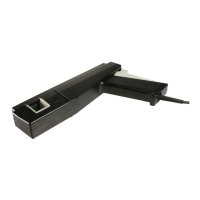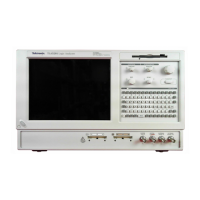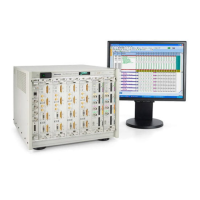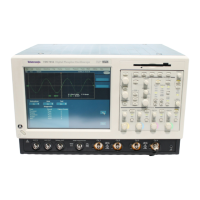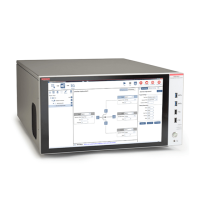Theory of operation
Making single-ended
measurements using the
P77BRWSR differential
probe tip
Making single-
ended measurements with a TriMode probe tip, such as a TekFlex
solder-in tip, is quite straightforward, because a TriMode tip provides solder
connections for a DUT ground reference for both the A and B probe inputs.
Although the differential input mode of the P7700 Series probe is normally
used to make a differential signal m easurement, single-ended measurements can
be made using Differential Input mode when the probe input connections and
offset volt
age controls are configur ed properly, This single-ended configuration
process is particularly important to understand when using the P77BRWSR
tip, since this variable-spacing Browser tip operates only in Differential Input
mode. Differential Input mode provides a measurement of the difference (A – B)
between the A and B input signals. If the probe tip B input is connected to a DUT
ground, the resulting Differential Input mode measurement (A – 0 V) results in a
display o
f the single-ended A input signal response.
When making differential signal measurements, the P77BRWSR Offset Voltage
control
is normally set to the Common-mode (CM) Tracking mode. With CM
tracking mode active, the A and B input signals are monitored and the Offset A
and Offset B settings are both adjusted to match the DC common-mode voltage of
the A and B input signals [(A + B)/2]. When making single-ended measurements
in Differential Input mode with a browser tip, the offset voltage control should
be set manually, so tracking mode should be shut off. The Offset A voltage
shou
ld be set manually to the center of the A signal voltage swing. For a +5 V
CMOS logic signal; for example, the Offset A voltage should be set to +2.5 V.
The A signal input voltage should then range from +5 V to 0 V, which is within
the 6 V
p-p
dynamic range of the Browser tip as long as the offset voltage is set
near the center of its expected voltage swing. The Offset B voltage should also
be set manually to 0 V. This Offset B voltage setting is not only at the center of
th
e dynamic range for a grounded B input signal, it also causes the differential
offset voltage to equal the Offset A voltage. This is true because the differential
offset voltage equals the difference between the Offset A voltage setting and the
Offset B voltage setting. The differential offset voltage is used by the oscilloscope
as the displayed offset voltage in Differential Input mode.
With the P77BRWSR tip configured for a single-ended measurement in
Differential Input mode, the displayed signal voltage should match the A input
signal response and the displayed offset voltage should match the Offset A
setting. Since the host oscilloscope uses both the displayed signal voltage and
displayed offset voltage in calculating its set of available oscilloscope automated
measurements, it is important that both the Differential Input mode signal voltage
and offset voltage are configured properly as shown in the following figure.
P7700 Series TriMode Probes Technical Reference 27
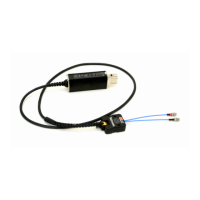
